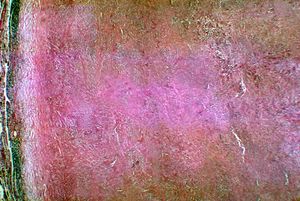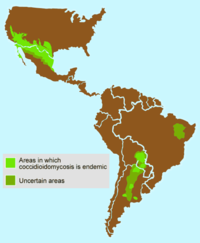فطار كرواني
| Coccidioidomycosis | |
|---|---|
 | |
| Histopathological changes in a case of coccidioidomycosis of the lung showing a large fibrocaseous nodule. | |
| التبويب والمصادر الخارجية | |
| التخصص | الأمراض المعدية (تخصص طبي) |
| ICD-10 | B38. |
| ICD-9-CM | 114 |
| MedlinePlus | 001322 |
| eMedicine | med/103 ped/423 |
| Patient UK | فشل عرض الخاصية P1461: لم يتم العثور على الخاصية P1461. فطار كرواني |
| MeSH | D003047 |
Coccidioidomycosis تعرف أيضا بحمى الوادى valley fever, San Joaquin Valley fever, California valley fever, و desert fever) is a fungal وهى عدوى تسببها Coccidioides immitis أو C. posadasii.[1] وهى endemic في بقاع معينة من العالمArizona, كاليفورنيا, Nevada, نيو مكسيكو, Texas, Utah و شمال غربي Mexico.[2]
C. immitis تتركز في تربة أجزاء معينة من جنوب غربى الولايات المتحدة, northern Mexico,وبقاع من Central و أمريكا الجنوبية [1]. وهى تكون كامنة أثناء فترات الجفاف, ثم تزدهر كفطر ذى خيوط طويلة التى سرعان ما تنفجر مخلفة كبسولات (Spores) حين يأتى موسم الأمطار. تلك الكبسولات المسماة arthroconidia, تنطلق في الهواء و بتعطيل التربة, مثل تجهيز الزراعة أو البناء خلال مواسم الحصاد . تحدث العدوى بواسطة إستنشاق الكبسولات. المرض لا ينتقل من شخص الى آخر . C. immitis هو dimorphic saprophytic كائن ينمو ك mycelium في التربة وينتج a spherule من الكائن العائل.
تقديم المرض
العدوى غالبا خفيفة, مع flu-like symptomsو طفح جلدى, Mayo Clinic تقدر أن نصف عدد السكان في بعض مناطق الإصابة يعانون من المرض . وهولاء المعرضون وبصفة خاصة ويشمل ذلك النساء الحوامل, و الأشخاص ذوى المناعة الضعيفة وهولاء من أصول آسيوية , Hispanic و أصول أفريقية يمكن أن يصابوا بعرض خطير بل ومميت من valley fever.المضاعفات الخطرة تشمل شديد pneumonia, lung nodules, and ينتشر المرض, حيث يخترق الفطر أجهزة الجسم . والجزء المنتشر من حمي الوادى(valley fever ) يمكن أن تدمر الجسم, مسببة قروحا جلدية و abscesses للعظام, آلآم شديدة بالعظام , إلتهاب بالقلب, urinary tractمشاكل, meningitis, و تعقبه الوفاة.
و قد أثضح أنها تصيب الإنسان, والكلاب والأغنام, والمواشي, حيوانات اللاما , , والقردة والكانجارو, والنمور والدببةmonke [3]
Symptomatic infection (40% of cases) usually presents as an influenza-like illness with fever, cough, headaches, rash, and myalgia (muscle pain).[4] Some patients fail to recover and develop chronic pulmonary infection or widespread disseminated infection (affecting meninges, soft tissues, joints, and bone). Severe pulmonary disease may develop in HIV-infected persons.[5] The disease can be fatal.
An additional risk is that health care providers who are unfamiliar with it or are unaware that the patient has been exposed to it may misdiagnose it as cancer and subject the patient to unnecessary surgery.[6][7]
التواجد
California state prisons have been particularly affected by Coccidioidomycosis, as far back as 1919. In 2005 and 2006, the Pleasant Valley State Prison near Coalinga and Avenal State Prison near Avenal on the western side of the San Joaquin Valley had the highest incidence rate in 2005, of at least 3,000 per 100,000 [2].
سلاح بيولوجى
C. immitis was investigated by the United States during the 1950s and 1960s as a potential biological weapon.[بحاجة لمصدر] The Cash strain received the military symbol OC, and original hopes were for its use as an incapacitant. As medical epidemiology later made clear, OC would have lethal effects on several segments of the population, so it was later considered a lethal agent. It was never standardized, and beyond a few field trials, it was never weaponized. Most military work on OC was on vaccines by the mid-1960s. It is still on the CDC's list of select agents however. (http://www.cdc.gov/od/sap/docs/salist.pdf)
إختبار تشخيصى
The fungal infection can be demonstrated by microscopic detection of diagnostic cells in body fluids, exudates, sputum and biopsy-tissue. With specific nucleotide primers C.immitis DNA can be amplified by PCR. It can also be detected in culture by morphological identification or by using molecular probes that hybridize with C.immitis RNA. An indirect demonstration of fungal infection can be achieved also by serologic analysis detecting fungal antigen or host antibody produced against the fungus.
العلاج
Mild cases often do not require treatment. PO Fluconazole and IV Amphotericin B are used in progressive or disseminated disease, or in which patients are immunocompromised. Alternatively, itraconazole or ketoconazole may be used.
علاج تجريبى للطب البيطرى
An experimental immune modulator is being evaluated by IMULAN BioTherapeutics, LLC in dogs with chronic, non responsive valley fever. The immune modulator is a T-Cell Receptor Peptide which has been shown to restore cell mediated immunity in a variety of models. Cell mediated immunity is required for appropriate immune surveillance.
It has been known to infect humans, dogs, cattle, livestock, llamas, apes, monkeys, kangaroos, wallabies, tigers, bears, badgers, otters and marine mammals.
الثقافة الشعبية
The illness is mentioned in episode 3x04 of the TV Show House, as the cause of a young girl's loss of inhibition. The illness does not actually cause loss of inhibition, nor does it cause milky tears.
It is also the center of an episode of Bones (1x09), The Man In the Fallout Shelter. After being exposed to the fungus, the team was quarantined over Christmas to determine whether or not they had become infected. It was erroneously claimed to be contagious from person to person.
It once again appears in the show Bones (2x17); The Priest in the Churchyard. Cam says the infected became exposed to it from graveyard dirt and no quarantine is imposed. They use it to track down a suspected grave robber later on in the episode.
Valley fever is also mentioned in the Pam Muñoz Ryan's 2000 novel Esperanza Rising, wherein the title character's mother contracts the disease following a California dust storm.
Another occurrence of valley fever in popular culture can be observed in episode 16 ("Bounce") of the sixth season of US TV series NCIS, where the autopsy of a murder victim reveals the disease to be present in the dead body.
صورإضافية
المراجع
- ^ Walsh TJ, Dixon DM (1996). Spectrum of Mycoses. In: Baron's Medical Microbiology (Baron S et al, eds.) (4th ed. ed.). Univ of Texas Medical Branch. (via NCBI Bookshelf) ISBN 0-9631172-1-1.
{{cite book}}:|edition=has extra text (help) - ^ Hector R, Laniado-Laborin R (2005). "Coccidioidomycosis--a fungal disease of the Americas". PLoS Med. 2 (1): e2. doi:10.1371/journal.pmed.0020002. PMID 15696207.
{{cite journal}}: CS1 maint: unflagged free DOI (link) - ^ Valley Fever Center for Excellence | url = http://www.vfce.arizona.edu/VFID-other.htm
- ^ Ryan KJ; Ray CG (editors) (2004). Sherris Medical Microbiology (4th ed. ed.). McGraw Hill. pp. 680–83. ISBN 0838585299.
{{cite book}}:|author=has generic name (help);|edition=has extra text (help)CS1 maint: multiple names: authors list (link) - ^ Ampel N (2005). "Coccidioidomycosis in persons infected with HIV type 1". Clin Infect Dis. 41 (8): 1174–8. doi:10.1086/444502. PMID 16163637.
- ^ Chen, Karl T. K. (1993). "Cytodiagnostic pitfalls in pulmonary coccidioidomycosis". Diagn Cytopathol. 12 (2): 177–180. doi:10.1002/dc.2840120220.
- ^ ValleyFeverSurvivor.com FAQ: "My Valley Fever has been misdiagnosed as cancer. Does this happen very often?" | url = http://www.valleyfeversurvivor.com/faq.html
أنظر أيضا
الروابط الخارجية
| Coccidioidomycosis
]].

